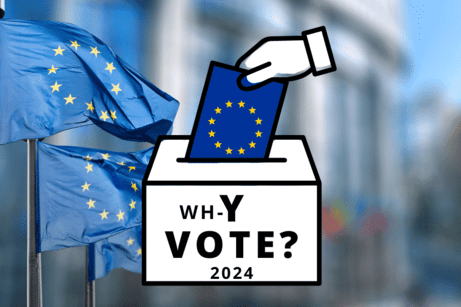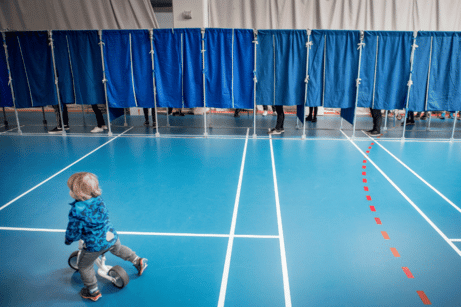
by Bernd Debusmann | 15 Aug 2024 | China, Government, History, Politics, Russia, Ukraine, United States
Go back three decades and the trend was towards global democracy. Now we see rising authoritarianism. Are we looking at global autocracy? Military tanks. (Credit: Mikhail Shapovalov/Getty Images) This article was produced exclusively for News Decoder’s global news...

by Lauren Heuser | 10 Jul 2024 | Decoder Replay, Government, History, Politics
When the rule of law doesn’t apply to world leaders, can they be reined in? Should a president or prime minister be above the law? A man takes a bribe. (Photo by Kazakov Anatoliy Pavlovich/Getty Images) Editor’s note: On 2 July 2024, the U.S. Supreme Court...

by News Decoder | 7 Jun 2024 | Educators' Catalog, Europe, Government, Politics, Wh-Y Vote
We asked our reporters in five countries to talk to young people about the European elections. They know their voice matters. A European ballot box against the backdrop of European Union flags. (Illustration by News Decoder) The 720-member European Parliament is the...
We asked our reporters in five countries to talk to young people about the European elections. The ensuing Wh-Y Vote? series sheds light on how young people across the European Union feel about voting in European elections. What influence do they believe the EU has on their lives? What are the issues driving them to or from polling stations? Why are young people voting or not voting?
Exercise: Students read the article and give feedback on the main issues described in each country. Then, choose to focus on one of the five countries mentioned. Use the links below the article to read the full piece on youth voting in your chosen country. In groups, summarize the main issues that were highlighted and discuss them. Now, together in your country groups, make a campaign poster mobilizing young people to vote in the European elections. Use the articles to help focus the campaign, and visit official EU websites to find more information on why young people should vote.

by Amina McCauley | 31 May 2024 | Environment, Europe, Government, Politics, Wh-Y Vote
With fjords dying and seas rising, Danish youth will go to the polls knowing the nation’s problems are transnational. People vote at the Groendal Center in Copenhagen during the European Parliament elections in 2019. (AP Photo/Mads Claus Rasmussen/Ritzau...

by Carlos Rubio | 30 May 2024 | Europe, Government, Politics, Wh-Y Vote
Freedom to travel across borders comes with EU citizenship. But will la jeunesse travel across town to vote as Europeans? French Green Party candidate for the European Elections Marie Toussaint speaks during a campaign rally in Strasbourg, France, 25 April 2024. The...

by News Decoder | 24 Apr 2024 | Decoder Replay, Economy, Government, United States
An announcement from the Federal Reserve of the United States can send investors around the world into a frenzy. We went to our experts to find out why. The gold vault of the Federal Reserve Bank of the United States. (Photo courtesy the Federal Reserve Bank)...

by Shefali Malhotra | 3 Mar 2023 | Africa, Educators' Catalog, Government, Technology, University of Toronto Journalism Fellows
If a government agency stores the DNA and fingerprints of its residents can it serve them more efficiently or control them more effectively? (Image: News Decoder) A year after Kenya’s historic digital identity program was declared illegal, the Kenyan government is...
As more countries around the world adopt digital identification systems, concerns about the legality of such programs have come to the fore. This month, University of Toronto global journalism fellow Shefali Malhotra walks us through arguments for and against the implementation of digital IDs in Kenya.
Exercise: As students are reading the article, have them create a list of arguments for and against the implementation of digital IDs. Then, have students write a paragraph on whether or not they support adopting digital IDs in your country. The paragraph should include arguments around at least two of the following subtopics: data protection (legal), privacy (personal & commercial), internet penetration/the digital divide, potential discrimination against vulnerable groups. To extend the activity, students can engage in a structured debate with classmates after writing their paragraphs.

by Barry Moody | 16 Nov 2022 | Educators' Catalog, Europe, Government, Politics
Britain’s Conservative Party won a landslide in 2019. Now the Tories and their elite are the butt of jokes overseas as polls point to possible humiliation. 10 Downing Street, the official residence and office of the British Prime Minister, in London, 20 October...
Politics can seem boring to some young people. But in Britain it is anything but. Correspondent Barry Moody takes us through the musical chairs of British prime ministers and shows how political divisions inside the British government over Brexit, taxes and the economy could lead to a breakup of the United Kingdom.
Exercise: Create teams of five. Each team should choose one member to be prime minister. The other four students should each take on the roles of England, Wales, Scotland and Northern Ireland. They should each do some basic research on their region’s current relationship with the British government. The student who is the prime minister will research and consider the importance of having these countries united into one government. Together they will create a poster that explains the individual identities of the four countries and how they benefit or are disadvantaged by their subordination to a united government.

by Helen Womack | 1 Mar 2022 | Europe, Government, Human Rights, Nationalism, Politics
As leader of Hungary, Viktor Orbán has thumbed his nose at EU values. Elections in April will test whether Hungarians want his “illiberal democracy.” An old tenement block in the Budapest district of Angyalföld, which reflects the split in Hungarian...

by Robert Holloway | 3 Feb 2022 | Europe, Government, Politics
French voters may have their minds on other matters ahead of April’s election, but President Emmanuel Macron stands firmly for a strong Europe. French President Emmanuel Macron at the European Parliament in Strasbourg, France, 19 January 2022 (Bertrans Guay,...










